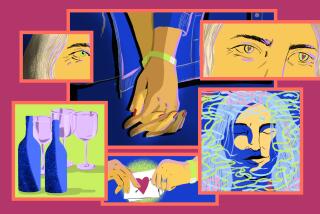In her inventive novel âThe Answers,â Catherine Lacey experiments with the components of love
âSuch a serious thing we are doing, and no one really knows how to do it,â Catherine Lacey declares in her new novel, âThe Answers.â Sheâs talking about love and the way we clumsily master it over the course of our lives, or maybe never figure it out at all. This is Laceyâs specialty: She captures with eerie precision the strangeness of being a person in the world, living alongside other human beings with unknowable thoughts and feelings.
In âThe Answers,â her heroine doesnât narrate her tale so much as expel it, like a blast of air forced out by a hard punch to the stomach. âThatâs one of my problems, Iâm told, getting ahead of myself, so Iâve been trying to find a way to get behind myself,â explains Mary Parsons at the start of this funny, wildly inventive novel. A twentysomething adrift in New York City, Mary has no romantic entanglements, a dead-end job and a debilitating, undiagnosable illness. The pain has left her feeling like âthe use of my body, the only thing I really owned, had somehow been repossessed.â In order to pay for a mysterious, pricey treatment called Pneuma Adaptive Kinesthesia, Mary applies for a job she finds on a health food store bulletin board. It turns out to be an elaborate pseudo-scientific research project funded by world-famous actor-auteur Kurt Sky.
The Girlfriend Experiment (a.k.a. GX) has been designed to document and quantify the act of falling in love. Mary joins a team of women trained to perform specific roles in Kurtâs daily life: The Intimacy Girlfriend team manages his sexual fulfillment; the Maternal Girlfriend prepares meals and cleans; the Intellectual Girlfriend serves as a sparring partner (though he quickly feels undermined by her intelligence); the Anger Girlfriend handles âfighting, nagging and emotional manipulation.â
Mary fills the Emotional Girlfriend role. In exchange for $1,450 a week, she follows strict guidelines and scripted interactions designed to elicit Kurtâs feelings. There is no reciprocity involved; Mary is his mirror and muse, her own desires irrelevant. In some ways, sheâs perfect for this wayward experiment. Mary seems numb to romance and sex, which has always felt to her ârandom, outside my control, like weather.â She is also utterly unimpressed by Kurtâs celebrity, having been raised off the grid by a fanatically religious father who cloistered her from popular culture and made loving God feel more real than loving real people, who are, after all, just âincomprehensible clots of flesh.â
Maryâs voice is both intimate and dissociated, decoding ordinary experiences as if explaining human rituals to an alien. Of her God-besotted father, she writes, âI wondered if he knew about how, in the real world, sometimes two sad people cry together and the person who is crying a little less grips the person who is crying more, holds them still until their crying lessens ⌠then they bend away from each other but keep their arms around each other and they let their eyes meet and one of them will make this tiny hurt smile.â
Reading Laceyâs fiction feels like walking through a dark apartment in someoneâs mind, full of winding hallways and unmarked doors. You never know quite where you are or where youâll end up. Like the work of Clarice Lispector or Rachel Cusk, Laceyâs novels seem to be on the verge of inventing a new genre somewhere between prose poem and fugue state. Laceyâs 2014 debut novel, âNobody Is Ever Missing,â revolved around an interior monologue about a woman traveling across New Zealand. âThe Answersâ is propelled by a surprisingly compelling puzzle of a plot involving the Girlfriend Experiment and the way it manipulates its subjects â but plot is just one of the novelâs many pleasures.
Lacey has great fun with the GX scenario, a pointed and funny dissection of an unspoken male fantasy in which women are distilled to their use value, while they participate in their own erasure. Occasionally it tips a little too far into broad satire, as with the introduction of the Anger Girlfriend. A project designed to suit a manâs needs might instead create a Scapegoat Girlfriend, whose sole purpose is to receive and diffuse his rage.
Kurt raises narcissism to hilarious high art: He commissions a minimalist gamma wave sound installation to stimulate his brain creativity and frequents a bar where a âbespoke cocktail artistâ mixes concoctions customized to enhance his psychic needs. He yearns for control over the world but will end up at the mercy of his own research, a meat puppet like the Girlfriends he hires.
The novel ultimately seems to ask whether Kurtâs Girlfriend Experiment is so different from Maryâs fatherâs quest for holiness or her own pursuit of the mystical PAK treatment. Lacey trails her characters as they search for meaning down rabbit holes of their own making. â[D]oes a person ever wish for instructions on how to best love the other people sleeping in their home â their children or partners, blood and chosen families?â Mary wonders at one point. âDoes the person wish they knew, for certain, for absolute certain, what their glances and touches and voices really do to those people? ⌠How to know anything, for certain, in anotherâs heart?â
In a book called âThe Answers,â Catherine Lacey leaves us with a ravishing list of questions.
Press is the author of a forthcoming book about women TV showrunners.
âThe Answersâ
Catherine Lacey
Farrar, Straus and Giroux: 304 pp., $26
More to Read
Sign up for our Book Club newsletter
Get the latest news, events and more from the Los Angeles Times Book Club, and help us get L.A. reading and talking.
You may occasionally receive promotional content from the Los Angeles Times.









